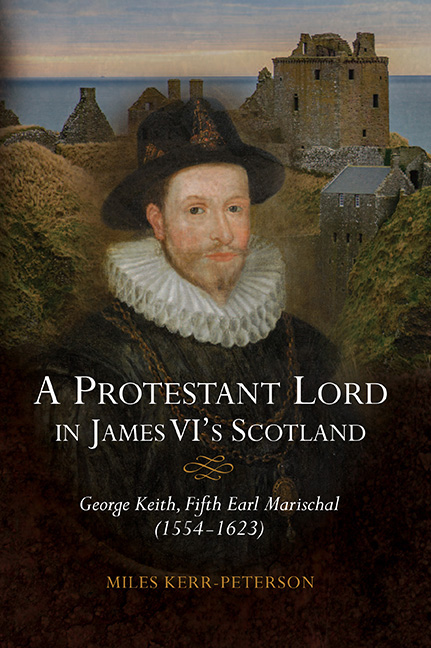Book contents
- Frontmatter
- Contents
- List of Illustrations
- Acknowledgements
- Conventions
- Abbreviations
- Map
- Introduction
- 1 Inheritance and Education, 1513–1582
- 2 Three Feuds and Jacobean Politics, 1582–1595
- 3 Service to the State, 1595–1623
- 4 Defending the Borders of the Earldom, 1595–1623
- 5 Family Strategies and Crises, 1595–1623
- 6 Lordship and the Reformed Kirk, 1560–1623
- 7 Economic Activities, 1581–1623
- 8 Marischal College, 1593–1623
- Conclusion
- Appendices: Genealogies
- Bibliography
- Index
- St Andrew Studies in Scottish History
1 - Inheritance and Education, 1513–1582
Published online by Cambridge University Press: 13 April 2019
- Frontmatter
- Contents
- List of Illustrations
- Acknowledgements
- Conventions
- Abbreviations
- Map
- Introduction
- 1 Inheritance and Education, 1513–1582
- 2 Three Feuds and Jacobean Politics, 1582–1595
- 3 Service to the State, 1595–1623
- 4 Defending the Borders of the Earldom, 1595–1623
- 5 Family Strategies and Crises, 1595–1623
- 6 Lordship and the Reformed Kirk, 1560–1623
- 7 Economic Activities, 1581–1623
- 8 Marischal College, 1593–1623
- Conclusion
- Appendices: Genealogies
- Bibliography
- Index
- St Andrew Studies in Scottish History
Summary
The origins of the Keiths are obscure. All that is known for certain is that they took their name from the lands of Keith in East Lothian and that the oldest traceable ancestor is Hervey de Keith in the reign of David I in the twelfth century. Hervey was in possession of lands at Keith by 1159, the previous owner there having been Gilbert de Umfraville. The current theory is that Hervey was of Norman or French origin. Regardless, George Keith, fifth Earl Marischal, had no doubts about his ancestry: he believed he was descended from the Germanic Chatti described by Tacitus, who, having been conquered by the Romans, had fled to Scotland and eventually established themselves as noblemen of the Scottish kingdom. Whatever the truth of this, before examining the fifth earl's early career, some account of the history of the Earl Marischals in general is essential, especially the careers of his grandfather (the fourth earl) and father (referred to below as the Master of Marischal).
The Earls Marischal
All extant records indicate that the Keiths always held the office of king's marischal, later great marischal of Scotland, then Earl Marischal. This role initially comprised little more than acting as the king's farrier, but developed during the medieval period into having responsibility for the victualling of the king's hall, military justice and organising tournaments. There is some suggestion that the office entailed command of the royal cavalry and, jointly with the constable (exercised by the Earls of Erroll), had jurisdiction over chivalric courts. By the sixteenth century it had developed into a largely ceremonial role. Contemporary details are frustratingly vague. George, the fifth earl, described the office only as Regii Architriclini, vulgo Marischalli ‘the royal master of feasts, commonly known as Marischal’. The 1699 genealogist of the Keiths is likewise light on detail, saying only that it was ‘an office of great dignity and eminence, and of great power in peace and war, foreby one of the chief ancient offices of the crown’. In the eighteenth century, Alexander Nisbett noted that the marischal was responsible for the maintenance of order within whatever building parliament was being held, ensuring both the safety and dignity of the monarch. It came with high ceremonial importance, processing to the left of the king (or his commissioner) in the riding of parliament.
- Type
- Chapter
- Information
- A Protestant Lord in James VI's ScotlandGeorge Keith, Fifth Earl Marischal (1554–1623), pp. 13 - 29Publisher: Boydell & BrewerPrint publication year: 2019



